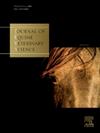Closed laceration of the trachea, esophagus and guttural pouches in a mare caused by blunt trauma
IF 1.3
3区 农林科学
Q2 VETERINARY SCIENCES
引用次数: 0
Abstract
A mare was admitted for progressive swelling of the neck, lethargy and anorexia. Radiography revealed perilaryngeal, peritracheal, and periesophageal emphysema. Endoscopy revealed pharyngeal and tracheal roof collapse, and a small laceration on the trachea. Treatment with antimicrobials, fluids, and flunixin was initiated. To prevent exacerbation of the emphysema, temporary tracheostomy was performed. Clipping for the tracheostomy revealed a hoofprint mark on the ventral neck. Subsequent endoscopies revealed laceration of the esophagus and guttural pouch septum communicating with the visceral compartment of the neck. Four days after admission, an esophagostomy was performed to prevent leakage of ingesta into the neck and allow feeding. Complications occurred: Deep cervical infection requiring surgical drainage; Esophageal impaction with shavings on one occasion causing extensive mucosa erosions; Laminitis managed with restricted physical activity and corrective farriery. Tracheostomy tube removal, esophagostomy tube removal, and patient discharge occurred 10, 36 and 51 days after admission, respectively. The mare did well after discharge and returned to competing in children's showing classes. Blunt trauma to the neck can lacerate the trachea, esophagus and guttural pouches causing emphysema and deep cervical infection, which can be treated with antimicrobials, temporary tracheostomy, temporary esophagostomy, surgical drainage, and supportive care.
一匹母马的气管、食道和胃囊因钝器伤造成闭合性撕裂伤。
一匹母马因颈部逐渐肿胀、嗜睡和厌食而入院。X光检查发现咽周、气管周围和食管周围气肿。内窥镜检查显示咽部和气管顶塌陷,气管上有一处小裂口。患者开始接受抗菌药、输液和氟尼辛治疗。为防止肺气肿加重,医生为患者实施了临时气管造口术。气管造口术前的剪切发现颈部腹侧有一个蹄印。随后的内窥镜检查发现食道和肠袋隔膜裂伤,与颈部内脏隔膜相通。入院四天后,医生为它实施了食管造口术,以防止食道分泌物渗入颈部,并允许进食。并发症发生了:颈部深度感染,需要进行手术引流;食道有一次被刨花堵塞,造成大面积粘膜糜烂;限制运动和矫正牵引,控制了褥疮。气管造口管拔除、食管造口管拔除和患者出院分别发生在入院后 10 天、36 天和 51 天。该母马出院后表现良好,重新参加了儿童马术比赛。颈部钝器伤会撕裂气管、食管和胃囊,导致气肿和颈部深部感染,可通过抗菌药、临时气管造口术、临时食管造口术、手术引流和支持性护理进行治疗。
本文章由计算机程序翻译,如有差异,请以英文原文为准。
求助全文
约1分钟内获得全文
求助全文
来源期刊

Journal of Equine Veterinary Science
农林科学-兽医学
CiteScore
2.70
自引率
7.70%
发文量
249
审稿时长
77 days
期刊介绍:
Journal of Equine Veterinary Science (JEVS) is an international publication designed for the practicing equine veterinarian, equine researcher, and other equine health care specialist. Published monthly, each issue of JEVS includes original research, reviews, case reports, short communications, and clinical techniques from leaders in the equine veterinary field, covering such topics as laminitis, reproduction, infectious disease, parasitology, behavior, podology, internal medicine, surgery and nutrition.
 求助内容:
求助内容: 应助结果提醒方式:
应助结果提醒方式:


